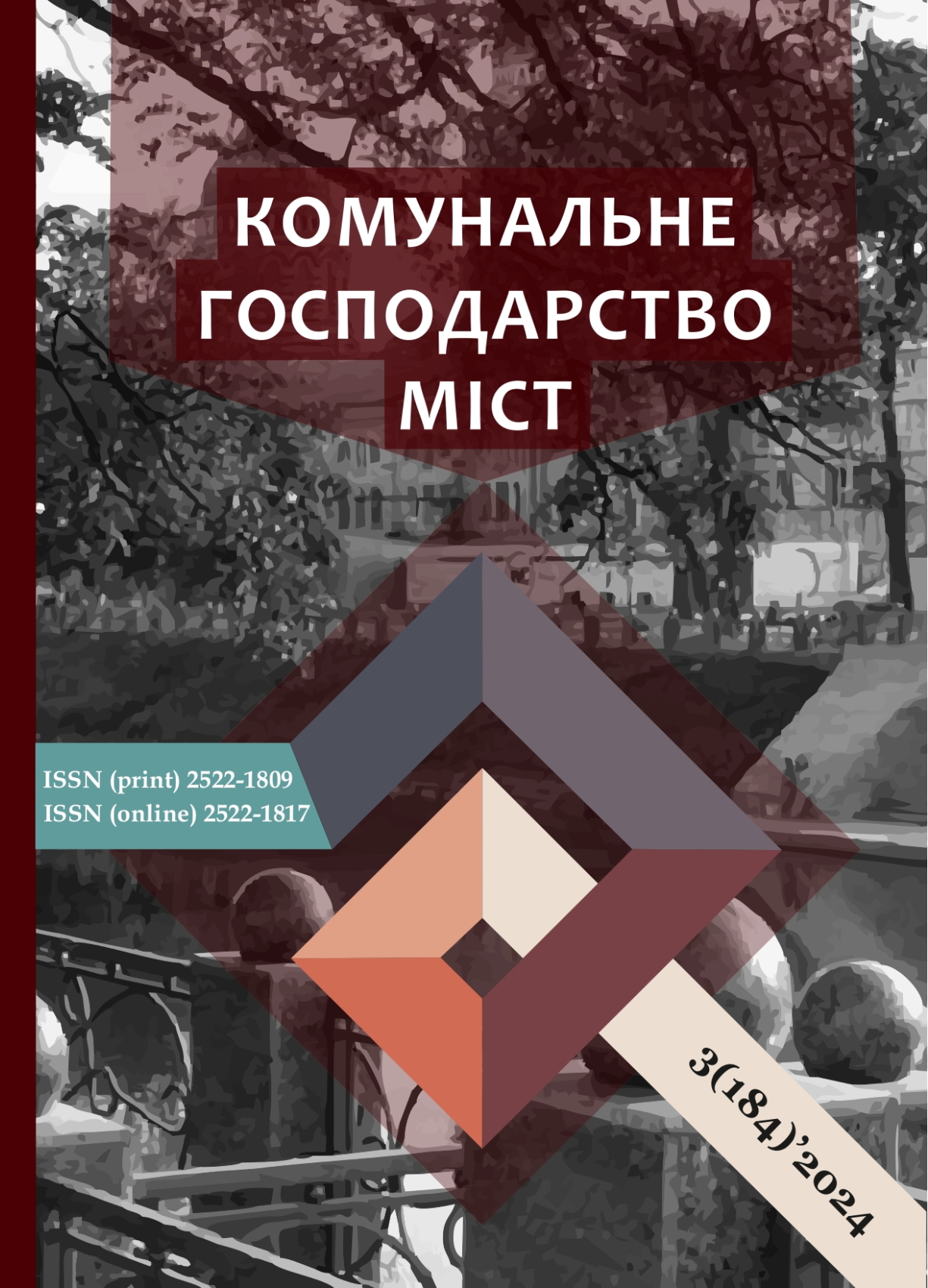GEOGRAPHIC INFORMATION MODEL OF PRECIPITATION INTENSITY
DOI:
https://doi.org/10.33042/2522-1809-2024-3-184-139-146Keywords:
modelling, precipitation intensity, geodatabase, geoprocessing, seasonality, software modules, SAGA GISAbstract
The paper analyses the technological features of building a geoinformation model to study the precipitation intensity in Ukraine. Analysis of natural phenomena requires promptness in obtaining and updating initial data. For this reason, today, geoinformation technologies most often use remote sensing data, mainly in raster format. We collected the raw data on precipitation intensity from the Global Precipitation Climatology Centre website of the German Meteorological Service (DWD). It is monthly data for 2022 in raster format with a raster size of 1 degree.
For the organisation and analysis of geographical information, we chose the most suitable new software product, SAGA GIS, designed for geoscientific analysis automation. The advantages of this system are the availability of a complete set of geophysical analysis methods, the spatial algorithms implementation, and open-source code.
After data loading, we geoprocessed the data, in particular, using the SAGA software module ‘Set Coordinate Reference System’ and selected the WGS84 coordinate system for the required layers. To prepare the data for analytical studies, we limited them to the administrative boundaries of Ukraine and transformed the WGS84 coordinate system into a UTM 36N projection. Using SAGA analytical tools, we grouped the data by season. Then, we determined the distribution of precipitation intensity over the territory for each season, identifying areas with the highest and lowest precipitation intensity and a part of the territory with the highest annual precipitation.
The results of this work may have practical significance for various sectors of the economy and decision-making on adaptation to climate change. They can be relevant both for scientific research and practical application in fields related to environmental assessment.
By supplementing the model with data for other subsequent or previous periods, it will be possible to determine trends in precipitation intensity by regions of Ukraine or physiographic zones of its territory.
References
The Effect of Climate Change on Water Resources and Programs / Watershed Academy Web. (2009). https://cfpub.epa.gov/watertrain/moduleFrame.cfm?parent_object_id=2469
Snizhko S., Shevchenko O., Didovets Yu. (2021). Analiz vplyvu klimatychnykh zmin na vodni resursy Ukrainy. Kyiv: Tsentr ekolohichnykh initsiatyv «Ekodiia».
Tarariko O. H., Syrotenko O. V., Ilienko T. V., Kuchma T. L. (2019). Ahroekolohichnyi suputnykovyi monitorynh : monohrafiia ; Instytut ahroekolohii i pryrodokorystuvannia NAAN. Kyiv: Ahrar. nauka.
Xander Wang, Lirong Liu. (2023). The Impacts of Climate Change on the Hydrological Cycle and Water Resource Management. Water, (15(13)), 2342. https://doi.org/10.3390/w15132342
Doi M.V., Kim J. (2021). Addressing Climate Internal Variability on Future Intensity-Duration-Frequency Curves at Fine Scales across South Korea. Water, (13(20):2828. https://doi.org/10.3390/w13202828
System of Environmental-Economic Accounting Ecosystem Accounting: Final Draft. Version 5. (2021). https://unstats.un.org/unsd/statcom/52nd-session/documents/BG-3f-SEEA-EA_Final_draft-E.pdf
Perspektyvy vykorystannia suputnykovoi informatsii dlia monitorynhu dosiahnennia tsilei staloho rozvytku Ukrainy : analitychna dopovid za rezultatamy vykonannia kompleksnoi prohramy NAN Ukrainy «Aerokosmichni sposterezhennia dovkillia v interesakh staloho rozvytku ta bezpeky yak natsionalnyi sehment proektu Horyzont-2020 ERA-PLANET» (ERA-PLANET/UA) u 2018-2020 rokakh. (2020). https://files.nas.gov.ua/PublicMessages/Documents/0/2020/12/201211203540797-7518.pdf
Cerilli, S., La Notte, A., Pisani, D., Vallecillo, S., & Tubiello, F. N. (2020). A sustainability scoreboard for crop provision in Europe. Ecosystem Services, 46, 101194. https://doi.org/10.1016/j.ecoser.2020.101194
Czúcz, B., Keith, H., Driver, A., Jackson, B., Nicholson, E., & Maes, J. (2021). A common typology for ecosystem characteristics and ecosystem condition variables. One Ecosystem, 6, e58218. https://doi.org/10.3897/oneeco.6.e58218
Havryliuk R., Stankevych-Volosianchuk O., Savchenko S. (2021). Ekosystemni posluhy ta hidroenerhetyka: pilotne zastosuvannia evropeiskykh instrumentiv u richkovykh baseinakh krain Skhidnoho partnerstva. Keis Ukrainy: analitychnyi dokument. – Kyiv: Natsionalnyi ekolohichnyi tsentr Ukrainy.
Sukanya S., Sabu J. (2023). Visualization Techniques for Climate Change with Machine Learning and Artificial Intelligence. (Pages 55-76). ScienceDirect. https://doi.org/10.1016/B978-0-323-99714-0.00008-X
Klimatolohichni doslidzhennia ta perspektyvy yikh rozvytку. Ukrainskyi hidrometeorolohichnyi tsentr Derzhavnoi sluzhby Ukrainy z nadzvychainykh sytuatsii. (2022). https://www.meteo.gov.ua/ua/Klimatolohichni-doslidzhennya
Baturinets, A. & Antonenko, S. (2019). Overview of soft-ware for analysis and visualization of hydrological data. Actual problems of automation and information technology. 23. 10.15421/431901.
Downloads
Published
How to Cite
Issue
Section
License
The authors who publish in this collection agree with the following terms:
• The authors reserve the right to authorship of their work and give the magazine the right to first publish this work under the terms of license CC BY-NC-ND 4.0 (with the Designation of Authorship - Non-Commercial - Without Derivatives 4.0 International), which allows others to freely distribute the published work with a mandatory reference to the authors of the original work and the first publication of the work in this magazine.
• Authors have the right to make independent extra-exclusive work agreements in the form in which they were published by this magazine (for example, posting work in an electronic repository of an institution or publishing as part of a monograph), provided that the link to the first publication of the work in this journal is maintained. .
• Journal policy allows and encourages the publication of manuscripts on the Internet (for example, in institutions' repositories or on personal websites), both before the publication of this manuscript and during its editorial work, as it contributes to the emergence of productive scientific discussion and positively affects the efficiency and dynamics of the citation of the published work (see The Effect of Open Access).

